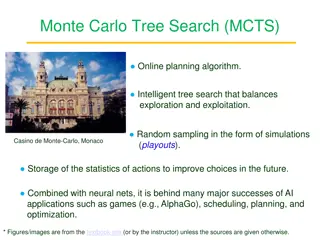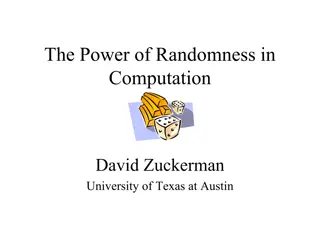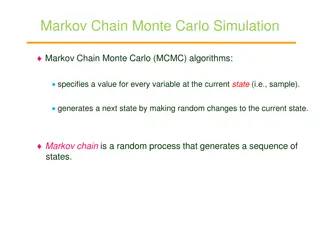Understanding Randomized Algorithms: A Deep Dive into Las Vegas and Monte Carlo Algorithms
Randomized algorithms incorporate randomness into computations, with Las Vegas algorithms always providing the correct answer but varying in time, while Monte Carlo algorithms occasionally give wrong answers. Quick Sort is a classic Las Vegas algorithm that involves pivoting elements for sorting. Choosing pivots close to the middle leads to better performance. The aim is to understand the working principles and performance considerations of randomized algorithms.
Download Presentation

Please find below an Image/Link to download the presentation.
The content on the website is provided AS IS for your information and personal use only. It may not be sold, licensed, or shared on other websites without obtaining consent from the author. Download presentation by click this link. If you encounter any issues during the download, it is possible that the publisher has removed the file from their server.
E N D
Presentation Transcript
Randomized Algorithms CSE 312 Spring 24 Lecture 27
Whats a randomized algorithm? A randomized algorithm is an algorithm that uses randomness in the computation. Well, ok. Let s get a little more specific.
Two common types of algorithms Las Vegas Algorithm Always tells you the right answer Takes varying amounts of time. Monte Carlo Algorithm Usually tells you the right answer. Sometimes the wrong one.
A classic Las Vegas Algorithm Remember Quick Sort? Pick a pivot element Move all the elements smaller than the pivot to the left subarray (in no particular order) Move all elements greater than the pivot element to the right subarray (in no particular order) Make two recursive calls It s sometimes implemented as a Las Vegas Algorithm. That is, you ll always get the same answer (there s only one sorted array) but the time can vary.
https://www.youtube.com/watch?v=ywWBy6J5gz8 Quick Sort 0 1 2 3 4 5 6 20 50 70 10 60 40 30 0 0 1 2 3 4 10 50 70 60 40 30 0 1 0 1 40 30 70 60 0 0 30 60 0 1 0 1 60 70 30 40 0 1 2 3 4 30 40 50 60 70 0 1 2 3 4 5 6 10 20 30 40 50 60 70
Total time: How long does it take? ? ? = ?(?2) ?=1 Well it depends on what pivots you pick. About ? levels ?(?) work when ? elements remaining.
For Simplicity We ll talk about how quicksort is really done at the end. For now an easier-to-analyze version: if(elements remaining > 1) pick a pivot uniformly at random split based on pivot sortedLeft = QuickSort(left half) sortedRight = QuickSort(right half) return (sortedLeft pivot sortedRight)
What leads to a good time? Pivots closer to the middle would be better. Cut in half is ideal. ?(log?) levels. ?(?) work when ? elements remaining. -- ?(?) per level
Work at each level How much work do those splits do? Each call choose a pivot ?(?) total per level Each element is compared to the pivot and possibly swapped ?(1) per element so ?(?) per level. So as long as we need at most ?(log?)levels, we ll get the ?(?log?) running time we need. We only get the perfect pivot with probability 1 likely maybe we can settle for something more likely. ?. That s not very
Focus on an element Let s focus on one element of the array ?1. The recursion will stop when every element is all alone in their own subarray. Call an iteration good for ?1 if the array containing ?1 in the next step is at most 3 4 the size it was in the current step. Pivot here: both subarrays 3/4 size. Must be good for ?1. Pivot here: might leave ?1 in a big subarray (if ?1 is small) Pivot here: might leave ?1 in a big subarray (if ?1 is big)
Good for ?? At least half of the potential pivots guarantee ?1 ends up with a good iteration. So we ll use ?1 good iteration 1/2 It s actually quite a bit more than half for large arrays one of the two red subarrays might might be good for ?1 (just bad for the others in the array) ?1might be our pivot, in which case it s totally done. To avoid any tedious special cases for small arrays, just say at least .
How many levels? How many levels do we need to go? Once ?1 is in a size 1subarray, it s done. How many iterations does it take? If we only had good iterations, we d need ? ? 3 4 4 3 ? log4/3?. ? 1 ? I want (at the end of our process) to say with probability at least <blah> the running time is at most ?(?log?). What s the probability of getting a lot of good iterations what s the tool we should use? pollev.com/robbie
Needed iterations ?1 is done after log4/3? =ln ? 4ln? good for ?? iterations. 4 3 ln Let s imagine we do 24ln(?) iterations. Let ? be the number of good for ?? iterations. Let ?~Bin 24ln ? ,1 2 (? 4ln?) (? 4ln?) Set up for Chernoff exp ?2? ? 1 ? 24 ln ? 2 2 1 ? = 1/3 ? = 2/3
Applying Chernoff 1 = ? 8 32 12 ln ? 2 exp ?2? ? 1 ? 24 ln ? 3 ln(?) exp 2 2 So, the probability that ?1 is not done after 24ln(?) iterations is at most ? 8ln(?)/3= ? 8/3
Finishing The bound So ?? is done with probability at least 1 ? 8/3 But ??being done doesn t mean the whole algorithm is done This argument so far does apply to any other ?? -- but they aren t independent, so .union bound! (algorithm not done) (?? done)= ? (?1 done)= ? ? 8 (algorithm done)> 1 ? 5/3. 3= ? 5/3
The Theorem Quicksort With probability at least 1 1 ?, Quicksort runs in time ?(? ??? ?) This kind of bound (with probability 1 as ? is called a high probability bound we say quicksort needs ?(?log?) time with high probability Better than finding a bound on the expected running time!
Want a different bound? Want an even better probability? You just have to tweak the constant factors! Be more careful in defining a good iteration or just change 24ln(?) to 48ln(?) or 100ln(?). It all ends up hidden in the big-O anyway. That s the power of concentration the constant coefficient affects the exponent of the probability.
Common Quicksort Implementations A common strategy in practice is the median of three rule. Choose three elements (either at random or from specific spots). Take the median of those for your pivot Guarantees you don t have the worst possible pivot. Only a small constant number of extra steps beyond the fixed pivot (find the median of three numbers is just a few comparisons). Another strategy: find the true median (very fancy, very impractical: take 421)
Monte Carlo Algorithms Just some intuition
Algorithms with some probability of failure There are also algorithms that sometimes give us the wrong answer. (Monte Carlo Algorithms) Wait why would we accept a probability of failure? Suppose your algorithm succeeds But given two runs of the algorithm, you can tell which is better. E.g. find the biggest <blah> whichever is bigger is the better one. succeeds with probability only 1/?. How many independent runs of the algorithm do we need to get the right answer with high probability?
Small Probability of Failure How many independent runs of the algorithm do we need to get the right answer with high probability? Probability of failure ? ? 1 1 Choose ? ln(?), and we get high probability of success. So ? ln(?) (for example) independent runs gives you the right answer with high probability. Even with very small chance of success, a moderately larger number of iterations gives high probability of success. Not a guarantee, but close enough to a guarantee for most purposes. ? ? ?


![[PDF READ ONLINE] LAS VEGAS TRAVEL GUIDE 2023: DISCOVERING THE EXCITEMENT AND BE](/thumb/2060/pdf-read-online-las-vegas-travel-guide-2023-discovering-the-excitement-and-be.jpg)




















